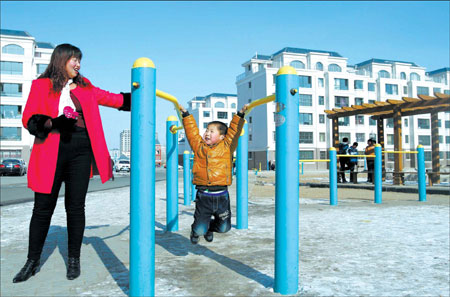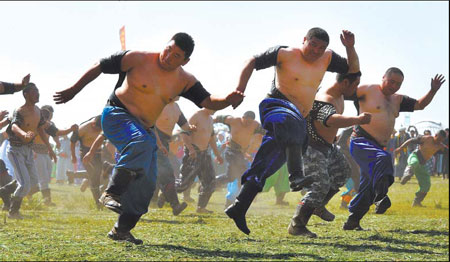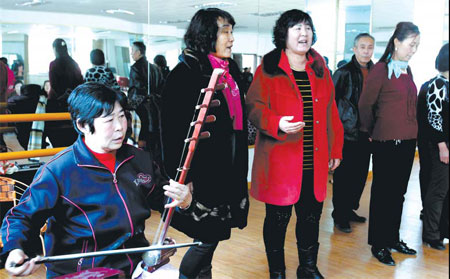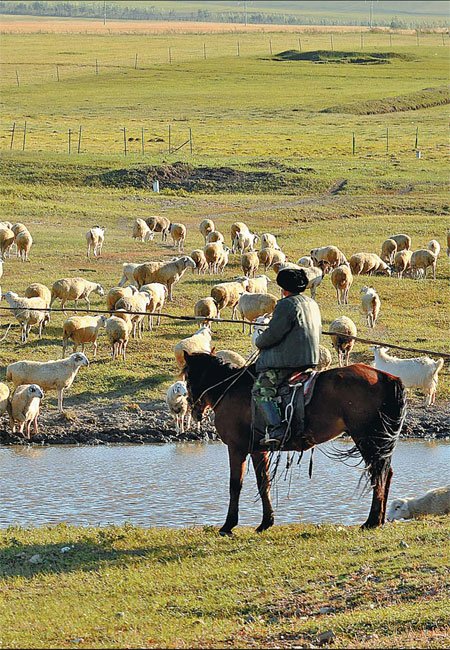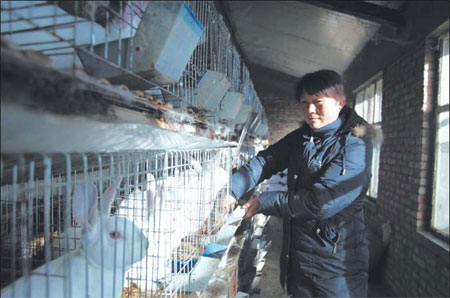Farmers turn urban in Ordos
Updated: 2013-02-19 07:59
By Wang Hao, Yang Wanli and Yang Fang (China Daily)
|
||||||||
|
Wanggui Xincun is one of the tens of 'new homes' in Ordos in the Inner Mongolia autonomous region, occupied by farmers and herdsmen who used to live in adobe or brick houses. Photos by Wang Jing / China Daily |
|
Wrestling is a traditional sport on the grassland of the autonomous region. Yu Changjun / for China Daily |
|
Residents of Wanggui Xincun enjoy themselves at the community club. Various clubs in the community offer entertainment. |
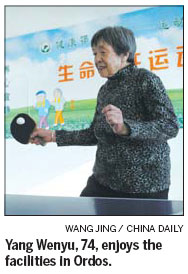
Ordos gives those who worked the land a chance of a new beginning, Wang Hao, Yang Wanli and Yang Fang report from Inner Mongolia.
Ordos, on the vast plateau of the Inner Mongolia autonomous region, has probably been China's most rapidly developing prefecture-level city during the past decade, as a result of the exploitation of its rich mineral resources.
With 13 percent of the country's coal and one-third of its natural gas reserves, Ordos boasts a higher per capita GDP than larger cities such as Beijing, Shanghai and Hong Kong. The city is investing great efforts in the management of social security and, in particular, township construction. Thousands of farmers and herdsmen, who could barely manage to make ends meet on the sandy land, are relocating to nearby towns.
Wanggui Xincun is one of the tens of "new homes" in Ordos occupied by farmers and herdsmen who used to live in adobe or brick houses.
Located close to the center of Dalate town, the residential community is home to more than 1,200 families. In addition to supermarkets and kindergartens, the community also has an entertainment center, where residents can play badminton, table tennis and billiards. It also has a fitness club and a library. Meanwhile, group activities can be held in rooms provided free of charge by the residents' committee.
Bai Yufeng, who moved from the suburbs of Dalate to Wanggui Xincun with his wife and son in August, is a member of the center's calligraphy club. Bai, 62, said that joining the club and practicing the art form with 30 friends has given added meaning to his post-retirement life.
"There was no public place for clubs in my old village. I could only practice calligraphy at home and so I felt lonely. Without a public activity center, there was really nothing for elderly people to do in winter," he said.
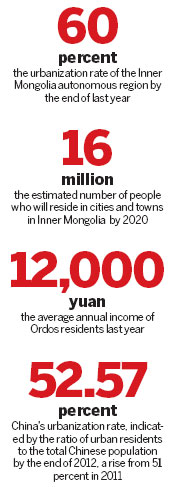
He was speaking in late January when the outside temperature was approximately -15 C and the cold weather made outdoor sports impossible. Inside the club, however, Bai needed little more protection than a sweater.
He said his family lived in a brick house for more than 20 years. The house, less than 20 square meters, consisted of just a dining room and one bedroom. In winter, family members only took a shower once a month because the house had no water heater and they had to bathe in public bathrooms.
Now, Bai's family lives in an apartment comprising a sitting room, a kitchen and two bedrooms, and they can shower as often as they like. Living much closer to the town hospital, Bai said his wife and he are happy in the new community. Moreover, the apartment was cheap, less than 1,000 yuan ($160) per square meter.
The farmers and herdsmen that have moved into the new residential area retain ownership of their farmland and houses in the rural area. Most of them have rented the land for the cultivation of sand willow (salix mongolica), a cold- and drought-tolerant, fast-growing tree, believed to be one of the most effective plants in the prevention of desertification.
In total, 500,000 farmers and herdsman have moved to the new residential areas, resulting in the average annual income rising from 2,500 to 12,000 yuan. The grassland has also undergone a tremendous change, with the vegetation-coverage rate expanding to more than 75 percent last year from 25 percent in 2000.
"We are lucky to be the first group of villagers to move to the township. Some of our relatives living in other districts are still waiting for the relocation program," said Bai.
Urbanization rate
Similar programs are also under way in a number of other cities and towns in Inner Mongolia. The urbanization rate of the autonomous region had risen to 60 percent by the end of last year from 42 percent in 2000. The number is expected to climb further to 65 percent by 2020, when more than 16 million people will live in cities and towns.
In the Dongsheng district of Ordos, the residential area has 126 buildings. Each six-story building has 12 apartments, two per floor. As part of a government project to relocate farmers and herdsman from the nearby counties of Hantai and Bojianghai, the apartments are sold at a price of 600 to 1,000 yuan per sq m, around a quarter of the market price of similar apartments.
Liu Qingshan, 69, and his 64-year-old wife moved to their new apartment in Dongsheng in early 2012. They came from a village in Hantai county, about 10 km from the downtown area they now call home. He said the relocation is good for him and his four children. "There was no food market in the village and we could only eat the few types of vegetables that we could grow ourselves. The youngsters couldn't stay in the village because they are aiming to make better careers in the cities. If we hadn't moved, it would have been hard for the children to take care of us."
It is estimated that China will have 160 million people aged 65 and older by 2020. Meanwhile, in the coming decades, the number of families comprising a couple, two sets of grandparents and a child will increase immensely, placing a much greater burden on middle-aged family members than in previous generations.
In Ordos, residents aged 60 and older account for 11 percent of the population, according to statistics released at the end of last year.
A perpetual spring
In recent years, nursing homes have emerged as one solution to the problem of the aging population. In Dongsheng, the services for senior citizens focus not only on providing meals and comfortable accommodation, but also on improving the quality of life.
The Xinhai Yihe nursing home covers an area of 54,000 sq m and consists of four types of building - single villas, terraced housing, apartment buildings and a nursing center. It also boasts a hospital and a supermarket. A hot spring, banks and a community center for the elderly are being built.
In the center's indoor garden, trees and flowers flourish while pavilions, lakes and bridges have been built to make the atmosphere feel like a perpetual spring. "The average age of the more than 300 residents is 75. The view out of the window is pretty dull and can make the residents depressed, so the garden has been designed to cheer them up," said Li Chang, marketing director of the home.
The suites in the center vary from one- to three-bedrooms and prices for accommodation and three meals a day range from 1,500 to 10,000 yuan per month. Each suite has air-conditioning, a refrigerator, a microwave and a TV. The washroom is equipped with handrails and emergency buttons. Wheelchairs are provided free of charge for those that need them.
Cai Shoubin, 76, and his wife Yang Wenyu, 74, moved to the center from their home in the center of Ordos a year ago. Their two daughters and son work in Guangzhou in South China's Guangdong province.
With a combined monthly pension of 9,000 yuan, the couple said they prefer to spend 3,000 yuan on nursing home fees rather than hiring a helper. "All the facilities here are for senior people. We have the nurses and also make more friends," said Cai.
Every morning, the elderly couple plays billiards and table tennis for two hours. In the afternoons, they spend 30 minutes relaxing in a massage chair provided free of charge.
According to Li, the nursing home also provides services to an increasing number of elderly residents living in other districts or towns. All the clients have their own health files, which are updated every week. Their children can see the documents online.
Industrial chain
For the middle-age group that grew up in villages and used to scratch a living from the land, urbanization has brought greater job opportunities and the chance to earn a higher income. That has promoted a change in skills.
Xu Chunqing is among the tens of thousands of residents of Inner Mongolia that have undergone the transition to an urban lifestyle. The 40-year-old mother of two lives in Dongda village, part of Dalate town, close to the east end of the Kubuqi desert in north Ordos. Last year, she earned 100,000 yuan, double the salary of a local government officer.
She earns her money by raising rex rabbits, a breed noted for its velvety fur. "Not every inch of Inner Mongolia is covered by grass and good for sheep and cattle. We live close to the desert, so farming can only provide just enough food to feed the family," she said.
Dongda village has a population of 120,000. About 10,000 families breed rex rabbits and foxes. Because the gravely soil provides poor farmland, young people worked in laundries or as waiters, nannies or security guards.
Starting in 1998, Xu worked as a dishwasher for almost 10 years, earning approximately 800 yuan per month for a 10-hour day, six days a week.
In 2009, she received a job offer from Dongda Corp, a local enterprise that has invested 10 billion yuan to support the rural poor. "I'd never heard of raising rabbits for profit before, so I only bought 72 from the company," she said.
Despite her doubts, Xu earned 2,300 yuan from the first batch of rabbits, which she sold after four months. That prompted her to quit her dishwashing job and sign a contract with the company to oversee two hutches, each containing 1,000 rabbits.
In the years that followed, Xu raised around 6,000 rabbits in the hutches annually, bringing an annual income of 100,000 yuan. She bought a car last year and plans to sign a contract for another 20 hutches. "I felt proud because I earned more than my husband," she said.
However, Xu's family is just one aspect of the environmental-friendly industrial system operating in the village. The local farmers have given up subsistence farming and have turned to cultivating sand willows.
The local soil is perfect for the hardy trees; a single sapling will grow to maturity in a year and, helpfully, grows more rapidly after the branches have been snapped off. The fresh leaves and saplings provide good food for the rabbits, and the wood can be used to produce furniture.
Rabbits, mink, raccoon dogs, foxes and wolves have become an industrial chain; the fur is used in the manufacture of clothing and the rabbit meat is processed for consumption. Small quantities of wolf meat are used in conjunction with herbs in the preparation of local, traditional medicines.
The chain not only makes full use of the materials at hand, but also protects the environment. It has provided a boost to local employment and brings a reliable income to the previously impoverished residents. Now, the village is aiming to raise more rabbits, increasing the number from 30 million to 100 million during the next five years.
For Xu, the move to the town has paid unexpected dividends. A decade ago, the family could not have supported a second child, but now her younger daughter, aged 4, is enrolled in a private kindergarten.
"Moving to the city is a dream for many villagers. It not only means better living conditions, but also a brighter future for the next generation," she said.
Contact the writers at wanghao@chinadaily.com.cn, yangwanli@chinadaily.com.cn and yangfang@chinadaily.com.cn
|
A herdsman looks after his sheep on the Hulunbuir grassland. Inner Mongolia has seen a rapid expansion of pasture land thanks to the policy to return low-yielding farmland to pasture and forests. Yu Changjun for China Daily |
|
Xu Chunqing's living standard has improved since she began to raise rex rabbits. Last year, the 40-year-old earned 100,000 yuan from her work. |
(China Daily 02/19/2013 page6)

 In Photos: 7.0-magnitude quake hits Sichuan
In Photos: 7.0-magnitude quake hits Sichuan
 Li Na on Time cover, makes influential 100 list
Li Na on Time cover, makes influential 100 list
 FBI releases photos of 2 Boston bombings suspects
FBI releases photos of 2 Boston bombings suspects
 World's wackiest hairstyles
World's wackiest hairstyles
 Sandstorms strike Northwest China
Sandstorms strike Northwest China
 Never-seen photos of Madonna on display
Never-seen photos of Madonna on display
 H7N9 outbreak linked to waterfowl migration
H7N9 outbreak linked to waterfowl migration
 Dozens feared dead in Texas plant blast
Dozens feared dead in Texas plant blast
Most Viewed
Editor's Picks

|

|

|

|

|

|
Today's Top News
Live report: 7.0-magnitude quake hits Sichuan, heavy casualties feared
Boston suspect cornered on boat
Cross-talk artist helps to spread the word
'Green' awareness levels drop in Beijing
Palace Museum spruces up
First couple on Time's list of most influential
H7N9 flu transmission studied
Trading channels 'need to broaden'
US Weekly

|

|
